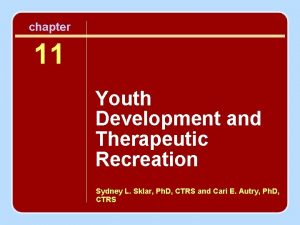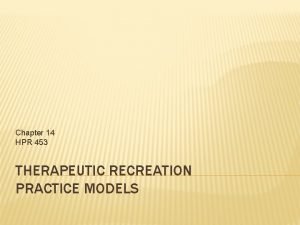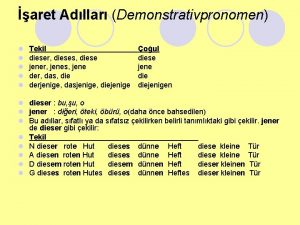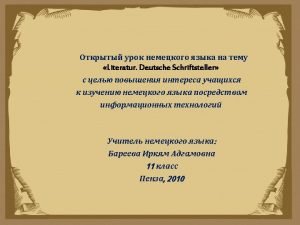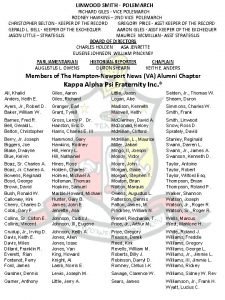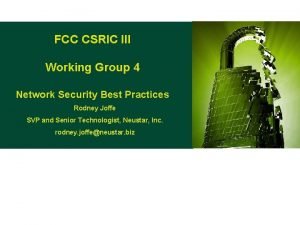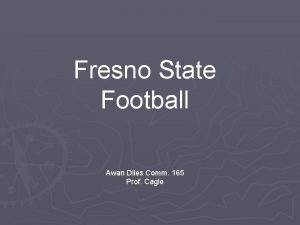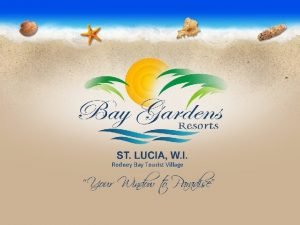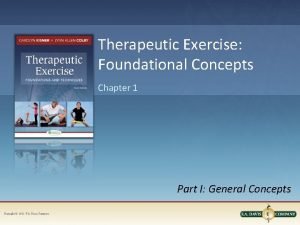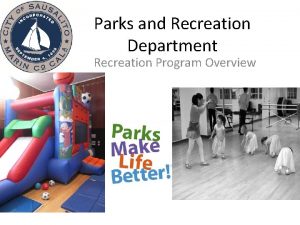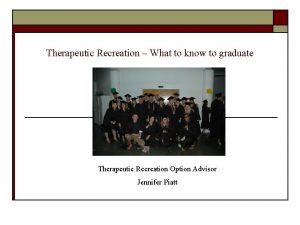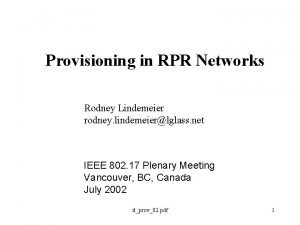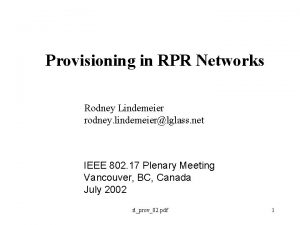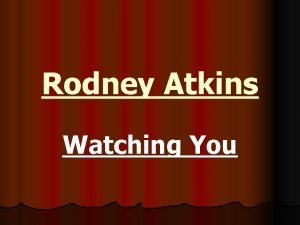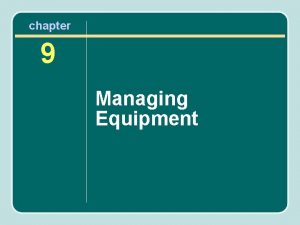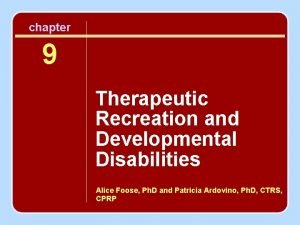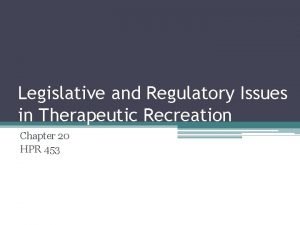chapter 2 History of Therapeutic Recreation Rodney Dieser

















- Slides: 17

chapter 2 History of Therapeutic Recreation Rodney Dieser, Ph. D

Learning Outcomes • Articulate why therapeutic recreation students should have a good understanding of the history of the profession of therapeutic recreation • Demonstrate how medical authority was used to justify leisure experiences • Identify how the profession of therapeutic recreation developed from both community and medical environments and how various sociological events (e. g. , world wars, settlement movement, legislation) affected the development of therapeutic recreation • Demonstrate how past (and current) philosophical battles in therapeutic recreation have affected the profession of therapeutic recreation • Articulate the difference between the leisure orientation and therapy orientation of therapeutic recreation

Why Understand History? • • • Help avoid past mistakes Document successes Predict consequences of actions Provide professional identity Support perceptions of present reality—how the past is interpreted affects the present

Origins of Therapeutic Recreation • Both community and clinical • European medical practices – – Humanitarian treatment network Phillippe Pinel and William Tuke Medical spas and thermal baths Florence Nightingale (table 2. 1) • World War I and World War II • Settlement houses

The Two World Wars • American Red Cross – Built recreation huts on military bases – Trained “hospital recreation” staff – Provided libraries, movies, entertainment, games, musical instruments, and other recreation opportunities for convalescing soldiers – Movement led to formation of the Hospital Recreation section of the American Recreation Society

Hull-House • Chicago settlement house • Started in September of 1889 – Jane Addams, Mary Keyser, Ellen Gates Starr • Used recreation programs in a therapeutic manner to address social problems – Expressive arts – Bibliotherapy – Leisure education

Philosophical Battles in Therapeutic Recreation (1945– 1966) • Therapeutic recreation after WWII – Menninger Clinic – Leisure experience • Leisure orientation to therapeutic recreation – Recreation and leisure based on freedom and choice – Hospital recreation • Recreation and leisure programming first • American Recreation Society (ARS) • Harold D. Meyer—rec-re-a-tor first! (continued)

Philosophical Battles in Therapeutic Recreation (1945– 1966) (continued) Therapy orientation to therapeutic recreation • Curative aspect of hospital recreation – Use recreation and leisure for medical purposes – Assist physicians in treatment – Select activities based on capabilities first • Recreational Therapy Section of American Association for Health, Physical Education, and Recreation (AAHPER) • National Association of Recreation Therapists (NART) (continued)

Philosophical Battles in Therapeutic Recreation (1945– 1966) (continued) Fragmented and disjoined profession • American Recreation Society (ARS) • American Association for Health, Physical Education, and Recreation (AAHPER) • National Association of Recreation Therapists (NART) • National Association of Recreation Services for the Handicapped

Utopian Years of Therapeutic Recreation (1966– 1984) • Social movement to unite professionals • National Recreation and Park Association (1966) formed from merger of the following: – – – National Recreation Association (NRA) American Institute of Park Executives (AIPE) National Confederation of State Parks (NCSP) American Association of Zoo Parks and Aquariums (AZA) American Recreation Society (ARS) • Merger and National Therapeutic Recreation Society (branch of NRPA) brought rights for people with disabilities to light – NART and Hospital Section of ARS merged into NTRS (continued)

Utopian Years of Therapeutic Recreation (1966– 1984) (continued) • National Council for Therapeutic Recreation Certification (NCTRC) (1981) • Focus on social and moral rights for people with disabilities – Normalization—making available to persons with disabilities what persons without disabilities experience daily – Inclusive recreation (table 2. 2) – Community reintegration—transition from clinic to community – Community integration—teaching leisure skills for participation – Community development—creating accessible and inclusive recreation sites and services

Fragmentation Years of Therapeutic Recreation (1985–present) • Attempt to arrive at one unified philosophy • Four approaches (table 2. 3) – – Recreation service approach Therapy approach Umbrella (combined) approach Leisure ability approach • Vote of NTRS membership • Leisure ability approach accepted in 1982 (continued)

Fragmentation Years of Therapeutic Recreation (1985–present) (continued) • Separatist mentality – Therapy approach supporters felt NRPA structure restricted ability of NTRS to serve its purpose – 1983: Separatists met at NRPA Convention in Kansas City to discuss creating a new organization – American Therapeutic Recreation Association (ATRA) was formally established in 1984 (continued)

Fragmentation Years of Therapeutic Recreation (1985–present) (continued) • Positive steps: ATRA and NTRS worked together on special projects – – Joint Task Force on Credentialing Alliance for Therapeutic Recreation Educators Conference National Conference on the Benefits of Therapeutic Recreation

Discussion Questions • Explain why students of therapeutic recreation should understand the history of their profession. • In regard to medical spas, thermal baths, and rest cures, explain why medical authority was needed to justify a leisure experience. To this end, do you agree or disagree with the following statement: A distinct feature of therapeutic recreation is its clear and direct association to recreation and leisure. Support your answer. • In regard to the history of therapeutic recreation, how are Jane Addams and Florence Nightingale similar? How are they different? (continued)

Discussion Questions (continued) • How did both world wars (as sociological events) affect the development of therapeutic recreation? • How did the development of Hull-House and other settlement houses affect community-based therapeutic recreation? • What conclusions can you draw about the philosophical battles in therapeutic recreation from 1945 through 1966? Do these past philosophical battles exist in the profession of therapeutic recreation today? (continued)

Discussion Questions (continued) • Explain why the utopian years of therapeutic recreation occurred from 1966 through 1984. • In your opinion, after the NTRS membership turned to a democratic method to identify its philosophical position, was it ethical for therapy-oriented therapeutic recreation specialists to break off and develop ATRA? Further, has the creation of ATRA helped or harmed the profession of therapeutic recreation? • In your interpretation of the history of therapeutic recreation, who is Victor Frankenstein and who is the monster? To this end, do you agree or disagree that the quest for grand achievement in therapeutic recreation has become the undoing of the profession?
 History of therapeutic recreation
History of therapeutic recreation Therapeutic recreation program sydney
Therapeutic recreation program sydney Therapeutic recreation models
Therapeutic recreation models Demonstrativ pronomen
Demonstrativ pronomen Licht dieser welt ich will dich anbeten
Licht dieser welt ich will dich anbeten Feiert jesus 3
Feiert jesus 3 Alle bücher dieser welt bringen dir kein glück
Alle bücher dieser welt bringen dir kein glück Game farming business plan
Game farming business plan Rodney grubb obituary
Rodney grubb obituary Duron shearn
Duron shearn Rodney joffe
Rodney joffe Rodney landrum
Rodney landrum Rodney joffe
Rodney joffe Helen rodney
Helen rodney Awan diles
Awan diles Village hotel at rodney bay
Village hotel at rodney bay Rodney kilcup
Rodney kilcup Therapeutic exercise chapter 1 mcqs
Therapeutic exercise chapter 1 mcqs

